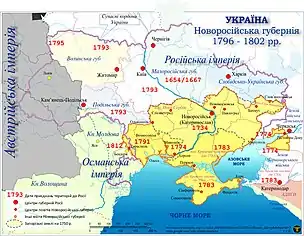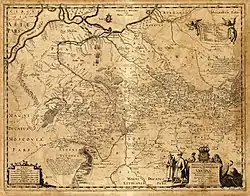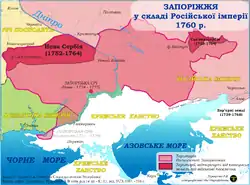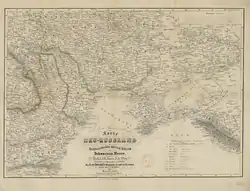Novorossiya
Novorossiya[nb 1] is a historical name, used during the era of the Russian Empire for an administrative area that would later become the southern mainland of Ukraine: the region immediately north of the Black Sea and Crimea. The province fell largely within a slightly wider area known in Ukrainian as the Stepovyna "Steppe Land", or Nyz "Lower Land".[1] The name Novorossiya, which means New Russia, entered official usage in 1764, after the Russian Empire conquered the Crimean Khanate, and annexed its territories,[2] when Novorossiya Governorate (or Province) was founded. Official usage of the name ceased after 1917, when the entire area was incorporated in the Ukrainian People's Republic (precursor of the Ukrainian SSR).

Novorossiya Governorate was formed (1764) from military frontier regions and parts of the southern Hetmanate, in anticipation of a war with the Ottoman Empire.[3] It was further expanded by the annexation of the Zaporozhian Sich in 1775. At various times, Novorossiya encompassed the Moldavian region of Bessarabia, the modern Ukraine's regions of the Black Sea littoral (Prychornomoria), Zaporizhzhia, Tavria, the Azov Sea littoral (Pryazovia), the Tatar region of Crimea, the area around the Kuban River, and the Circassian lands.
History
Wild Fields


The modern history of the region follows the fall of the Golden Horde. The eastern portion was claimed by the Crimean Khanate (one of its multiple successors), while its western regions were divided between Moldavia and Lithuania. With the expansion of the Ottoman Empire, the whole Black Sea northern littoral region came under the control of the Crimean Khanate that in turn became a vassal of the Ottomans. Sometime in the 16th century the Crimean Khanate allowed the Nogai Horde which were displaced from its native Volga region by Muscovites and Kalmyks to settle in the Black Sea steppes.
Vast regions to the North of the Black Sea were sparsely populated and were known as the Wild Fields (as translated from Polish or Ukrainian), Dykra (in Lithuanian) or Loca deserta ("desolated places") in Latin on medieval maps. There were, however, many settlements along the Dnieper River. The Wild Fields had covered roughly the southern territories of modern Ukraine; some say they extended into the modern Southern Russia (Rostov Oblast).
Russian expansion

The Russian Empire gradually gained control over the area, signing peace treaties with the Cossack Hetmanate and with the Ottoman Empire at the conclusion of the Russo-Turkish Wars of 1735–39, 1768–74, 1787–92 and 1806–12. In 1764 the Russian Empire established the Novorossiysk Governorate; it was originally to be named after the Empress Catherine, but she decreed that it should be called New Russia instead.[4] Imperial Russia’s view of New Russia was described in 2006 by the historian Willard Sunderland:
The old steppe was Asian and stateless; the current one was state-determined and claimed for European-Russian civilization. The world of comparison was now even more obviously that of the Western empires. Consequently it was all the more clear that the Russian empire merited its own New Russia to go along with everyone else's New Spain, New France, and New England. The adoption of the name of New Russia was in fact the most powerful statement imaginable of Russia's national coming of age.[5]
The administrative centre of the Novorossiysk Governorate was at the St. Elizabeth fortress (today in Kropyvnytskyi) in order to protect the southern borderlands from the Ottoman Empire, and in 1765 this passed to Kremenchuk.[4][6]
After the annexation of the Ottoman territories to Novorossiya in 1774, the Russian authorities commenced a broad program of colonization, encouraging large migrations from a broader spectrum of ethnic groups. Catherine the Great invited European settlers to these newly conquered lands: Romanians (from Moldavia, Wallachia and Transylvania), Bulgarians, Serbs, Greeks, Albanians, Germans, Poles, Italians, and others. Catherine the Great granted Prince Grigori Potemkin (1739–1791) the powers of an absolute ruler over the area from 1774, after which he directed the Russian colonization of the land. The rulers of Novorossiya gave out land generously to the Russian nobility (dvoryanstvo) and the enserfed peasantry—mostly from Ukraine and fewer from Russia—to encourage immigration for the cultivation of the then sparsely populated steppe. According to the Historical Dictionary of Ukraine:
The population consisted of military colonists from hussar and lancer regiments, Ukrainian and Russian peasants, Cossacks, Serbs, Montenegrins, Hungarians, and other foreigners who received land subsidies for settling in the area.[7]
In 1775, the Russian Empress Catherine the Great forcefully liquidated the Zaporizhian Sich and annexed its territory to Novorossiya, thus eliminating the independent rule of the Ukrainian Cossacks. The governorate was dissolved in 1783. In 1792, the Russian government declared that the region between the Dniester and the Bug was to become a new principality named "New Moldavia", under Russian suzerainty.[8] According to the first Russian census of the Yedisan region conducted in 1793 (after the expulsion of the Nogai Tatars) 49 villages out of 67 between the Dniester and the Southern Bug were Romanian.[9] From 1796 to 1802 Novorossiya was the name of the reestablished Governorate with the capital Novorossiysk (previously and subsequently Ekaterinoslav, the present-day Ukrainian city of Dnipropetrovsk not to be confused with present-day Novorossiysk, Russian Federation) In 1802 it was divided into three governorates, the Yekaterinoslav, Kherson, and the Taurida.

From 1822 to 1874 the Novorossiysk-Bessarabia General Government was centred in Odesa. The region remained part of the Russian Empire until its collapse following the Russian February Revolution in early March 1917, after which it became part of the short-lived Russian Republic. In 1918, it was largely included in the Ukrainian State and in the Ukrainian Soviet Republic at the same time. In 1918–1920, it was, to varying extents, under the control of the anti-Bolshevik White movement governments of South Russia whose defeat signified the Soviet control over the territory, which became part of the Ukrainian Soviet Socialist Republic, within the Soviet Union in 1922.
Legacy
Following the Soviet Union's collapse on 26 December 1991 and concurrent with the lead-up to Ukrainian independence on 24 August 1991, a nascent movement began in Odesa for the restoration of Novorossiya region; it however failed within days and never defined its borders.[10][11][12] The initial conception had not developed exact borders, but focus centred on the Odesa, Mykolaiv, Kherson, and Crimean oblasts, with eventually other oblasts joining as well.[12][13]
The name received renewed emphasis when Russian President Vladimir Putin stated in an interview on 17 April 2014 that the territories of Kharkiv, Luhansk, Donetsk, Kherson, Mykolaiv and Odesa were part of what was called Novorossiya.[14][nb 2] In May 2014, the self-proclaimed Donetsk People's Republic and Luhansk People's Republic proclaimed the confederation of Novorossiya and its desire to extend its control towards all of southeastern Ukraine.[17] The confederation had little practical unity and within a year the project was abandoned: on 1 January 2015 the founding leadership announced the project had been put on hold, and on 20 May the constituent members announced the freezing of the political project.[18][19] During the Wagner Group mutiny in June 2023, President Putin used the phrase in a speech responding to the mutiny, praising those "who fought and gave their lives to Novorossiya and for the unity of the Russian world".[20]
Demographics
Ethnicity
The ethnic composition of Novorossiya changed during the beginning of the 19th century due to the intensive movement of colonists who rapidly created towns, villages, and agricultural colonies. During the Russo-Turkish Wars, the major Turkish fortresses of Ozu-Cale, Akkerman, Khadzhibey, Kinburn and many others were conquered and destroyed. New cities and settlements were established in their places. Over time the ethnic composition varied.
Multiple ethnicities participated in the founding of the cities of Novorossiya (most of these cities were expansions of older settlements[21]). For example:
- Zaporizhzhia as formerly the site of a Cossack fort
- Odesa, founded in 1794 on the site of a Tatar village (the first recorded mention of a settlement located in current Odesa was in 1415[21]) by a Spanish general in Russian service, Jose de Ribas, had a French mayor, Richelieu (in office 1803–1814)
- Donetsk, founded in 1869, was originally named Yuzovka (Yuzivka) in honor of John Hughes, the Welsh industrialist who developed the coal region of the Donbas
According to the report of governor Shmidt, the ethnic composition of Kherson Governorate (which included the city of Odesa) in 1851 was as follows:[22]
| Nationality | Number | % |
|---|---|---|
| Ukrainians | 703,699 | 69.14 |
| Romanians (Moldavians and Vlachs) | 75,000 | 7.37 |
| Jews | 55,000 | 5.40 |
| Russian-Germans | 40,000 | 3.93 |
| Great Russians | 30,000 | 2.95 |
| Bulgarians | 18,435 | 1.81 |
| Belarusians | 9,000 | 0.88 |
| Greeks | 3,500 | 0.34 |
| Romani people | 2,516 | 0.25 |
| Poles | 2,000 | 0.20 |
| Armenians | 1,990 | 0.20 |
| Karaites | 446 | 0.04 |
| Serbs | 436 | 0.04 |
| Swedes | 318 | 0.03 |
| Tatars | 76 | 0.01 |
| Former Officials | 48,378 | 4.75 |
| Nobles | 16,603 | 1.63 |
| Foreigners | 10,392 | 1.02 |
| Total Population | 1,017,789 | 100 |
Language
With regard to language usage, Russian was commonly spoken in the cities and some outside areas, while Ukrainian generally predominated in rural areas, smaller towns, and villages.
The 1897 All-Russian Empire Census statistics show that Ukrainian was the native language spoken by most of the population of Novorossiya, but with Russian and Yiddish languages dominating in most city areas.[23][24][25]

| Language | Kherson Guberniya | Yekaterinoslav Guberniya | Tavrida Guberniya |
|---|---|---|---|
| Ukrainian | 53.4% | 68.9% | 42.2% |
| Russian | 21.0% | 17.3% | 27.9% |
| Belarusian | 0.8% | 0.6% | 6.7% |
| Polish | 2.1% | 0.6% | 0.6% |
| Bulgarian | 0.9% | – | 2.8% |
| Romanian | 5.3% | 0.4% | 0.2% |
| German | 4.5% | 3.8% | 5.4% |
| Jewish (sic) | 11.8% | 4.6% | 3.8% |
| Greek | 2.3% | 2.3% | 1.2% |
| Tatar | 8.2% | 8.2% | 13.5% |
| Turkish | 2.6% | 2.6% | 1.5% |
| Total Population | 2,733,612 | 2,311,674 | 1,447,790 |
The 1897 All-Russian Empire Census statistics:[26]
| Language | Odesa | Yekaterinoslav | Mykolaiv | Kherson | Sevastopol | Mariupol | Donetsk district |
|---|---|---|---|---|---|---|---|
| Russian | 198,233 | 47,140 | 61,023 | 27,902 | 34,014 | 19,670 | 273,302 |
| Jewish (sic) | 124,511 | 39,979 | 17,949 | 17,162 | 3,679 | 4,710 | 7 |
| Ukrainian | 37,925 | 17,787 | 7,780 | 11,591 | 7,322 | 3,125 | 177,376 |
| Polish | 17,395 | 3,418 | 2,612 | 1,021 | 2,753 | 218 | 82 |
| German | 10,248 | 1,438 | 813 | 426 | 907 | 248 | 2,336 |
| Greek | 5,086 | 161 | 214 | 51 | 1,553 | 1,590 | 88 |
| Total Population | 403,815 | 112,839 | 92,012 | 59,076 | 53,595 | 31,116 | 455,819 |
List of founded cities
Many of the cities that were founded (most of these cities were expansions of older settlements[21]) during the imperial period are major cities today.
Imperial Russian regiments were used to build these cities, at the expense of hundreds of soldiers’ lives.[21]
First wave
- Yelisavetgrad (Kropyvnytskyi) (1754)
- Aleksandrovsk (Zaporizhzhia) (1770)
- Yekaterinoslav (Dnipro) (1776)
- Kherson (1778)
- Mariupol (1778)
- Sevastopol (1783)
- Simferopol (1784)
- Melitopol (1784)
- Pavlohrad (1784)
Third wave
- Berdyansk (1827)
- Novorossiysk (1838)
See also
Notes
- Russian: Новороссия, tr. Novorossiya, IPA: [nəvɐˈrosːʲɪjə] ⓘ; Ukrainian: Новоросія, romanized: Novorosiia; Romanian: Noua Rusie, Polish: Noworosja
- Kharkiv was the centre of the historical region of Sloboda Ukraine.[15] A portion of modern Kharkiv Oblast includes territory of the late-eighteenth century Novorossiya Governorate.[16]
References
- Mikhail Levchenko (1874). Opyt russko-ukrainskago slovari︠a︡. Kyiv: Tip. Gubernskago upravlenii︠a︡, p 188.
- "Plan for the Colonization of New Russia Gubernia" issued by the Russian Senate - New Russia Gubernia at the Encyclopedia of Ukraine
- Magocsi, Paul R. "A History of Ukraine: The Land and Its Peoples," p. 284.
- Nataliya Polonska-Vasylenko (1955). The Settlement of the Southern Ukraine (1750-1775). Ukrainian Academy of Arts and Sciences in the U.S. p. 190.
- Willard Sunderland (2006). Taming the Wild Field: Colonization and Empire on the Russian Steppe. Cornell University Press. p. 70. ISBN 0-8014-7347-0.
- "New Russian gubernia". Encyclopedia of Ukraine. Archived from the original on 15 August 2015. Retrieved 4 January 2015.
- Ivan Katchanovski; Zenon E. Kohut; Bohdan Y. Nebesio; Myroslav Yurkevich (21 June 2013). Historical Dictionary of Ukraine. Scarecrow Press. p. 392. ISBN 978-0-8108-7847-1.
- E. Lozovan, Romanii orientali, "Neamul Romanesc", 1/1991, p.14
- E. Lozovan, Romanii orientali, "Neamul Romanesc", 1/1991, p.32.
- "The CIS Handbook", edited by Patrick Heenan, Monique Lamontagne, Fitzroy Dearborn Publishers, 1999, p. 75.
- "Federal State of Novorossiya". GlobalSecurity.org. Archived from the original on 9 August 2014. Retrieved 18 February 2015.
A Russian ethnic republic in Ukraine was named Novorossiya and was proclaimed in 1992 but fell some days after.
- Paul Kolstoe. "Russians in the Former Soviet Republics", Indiana University Press, June 1995, p. 176.
- Zbigniew Brzezinski; Paige Sullivan (1997). Russia and the Commonwealth of Independent States: Documents, Data, and Analysis. Center for Strategic and International Studies (Washington, D.C.); M.E. Sharpe Inc. p. 639. ISBN 978-1-56324-637-1.
- "Transcript: Vladimir Putin's April 17 Q&A". Washington Post. Archived from the original on 8 February 2015. Retrieved 18 February 2015.
- Unmaking Imperial Russia: Mykhailo Hrushevsky and the Writing of Ukrainian History by Serhii Plokhy, University of Toronto Press, 2005, ISBN 0802039375 (page 19)
- Frontline Ukraine: Crisis in the Borderlands by Richard Sakwa, I.B. Tauris, 2015, ISBN 1784530646 (page 9)
- СМИ: Террористы из "ДНР" и "ЛНР" объединились [Mass media: Terrorists of the "LNR" and "DNR" have united] (in Russian). UNIAN. 24 May 2014. Archived from the original on 25 May 2014. Retrieved 26 May 2014.
- "Russian-backed 'Novorossiya' breakaway movement collapses". Ukraine Today. 20 May 2015. Archived from the original on 21 May 2015. Retrieved 17 June 2016.
Vladimir Dergachev; Dmitriy Kirillov (20 May 2015). Проект «Новороссия» закрыт [Project "New Russia" is closed]. Gazeta.ru (in Russian). Archived from the original on 19 December 2016. Retrieved 17 June 2016. - "Why the Kremlin Is Shutting Down the Novorossiya Project". Carnegie Endowment for International Peace. Archived from the original on 22 December 2015. Retrieved 20 December 2015.
- "'Internal betrayal': Transcript of Vladimir Putin's address". Al Jazeera.
- Odesa: Through Cossacks, Khans and Russian Emperors Archived 24 October 2018 at the Wayback Machine, The Ukrainian Week (18 November 2014)
- Шмидт А. "Материалы для географии и статистики, собранные офицерами генерального штаба. Херсонская губерния. Часть 1". (tr. "Schmidt A.: Materials for geography and statistics collected by officers of the general staff. Kherson province. Part 1") St. Petersburg, 1863, p. 465-466
- "First General Census of the Russian Empire of 1897. Breakdown of population by mother tongue: Kharkov governorate - total population". Demoskop Weekly. Demoscope Weekly (№ 623–624). 31 December 2014. ISSN 1726-2887. Archived from the original on 2 May 2014. Retrieved 4 January 2015.
- "First General Census of the Russian Empire of 1897. Breakdown of population by mother tongue: Kherson district - the city of Kherson". Demoskop Weekly. Demoscope Weekly (№ 623–624). 31 December 2014. ISSN 1726-2887. Archived from the original on 4 March 2016. Retrieved 4 January 2015.
- "First General Census of the Russian Empire of 1897. Breakdown of population by mother tongue: Kherson district - the city of Nikolayev (military governorate)". Demoskop Weekly. Demoscope Weekly (№ 623–624). 31 December 2014. ISSN 1726-2887. Archived from the original on 17 May 2014. Retrieved 4 January 2015.
- "First General Census of the Russian Empire of 1897. Breakdown of population by mother tongue: Donetsk district - total population". Demoskop Weekly. Demoscope Weekly (№ 623–624). 31 December 2014. ISSN 1726-2887. Archived from the original on 11 September 2014. Retrieved 4 January 2015.
External links
 Media related to Novorossiya at Wikimedia Commons
Media related to Novorossiya at Wikimedia Commons- Map of Novorossiya (New Russia)
- Novorossiya leaders and Odesa mayors